
Philadelphus lewisii, the Lewis' mock-orange, mock-orange, Gordon's mockorange, wild mockorange,Indian arrowwood, or syringa, is a deciduous shrub native to western North America, and is the state flower of Idaho.

Delphinium andersonii is a species of perennial larkspur known as Anderson's larkspur. This wildflower is native to western North America, where it can be found in the Great Basin and the Sierra Nevada.

Gentianopsis holopetala is a species of flowering plant in the gentian family known by the common names Sierra fringed gentian or just "Sierra gentian"'. It is native to the Sierra Nevada and adjacent mountains in California and Nevada, in wet meadows from 6000 to 11,000 ft in elevation. This is an annual or perennial herb, growing stems which may be anywhere from a few centimeters long to nearly half a meter, and may lay along the ground or grow erect. Its small oval or spoon-shaped leaves are mostly basal but may grow sparsely further along the stem.
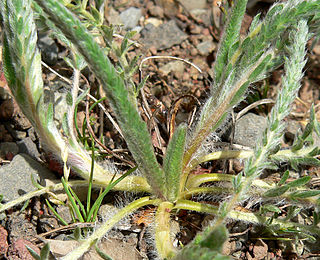
Potentilla sericoleuca, commonly known as Plumas mousetail and Plumas ivesia, is a species of flowering plant in the rose family.
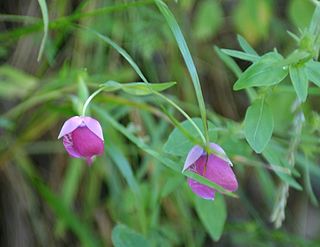
Calochortus amoenus is a species of flowering plant in the lily family which is commonly known as purple fairy-lantern.

Calochortus monophyllus is a North American species of flowering plants in the lily family known by the common name yellow star-tulip.

Calyptridium monospermum, synonym Cistanthe monosperma, is a perennial plant in the miner's lettuce family (Montiaceae), known by the common name one-seeded pussypaws. It was formerly classified in the purslane family (Portulacaceae).

Caulanthus pilosus is a species of flowering plant in the family Brassicaceae known by the common names hairy wild cabbage and chocolate drops. It is native to open, dry habitat in the Great Basin of Nevada, the Eastern slope of the Sierra Nevada to 9,000 ft (2,700 m) and surrounding regions of the United States northward to the SE corner of Oregon. It is an annual or occasionally perennial herb coated in thin hairs, especially toward the base.
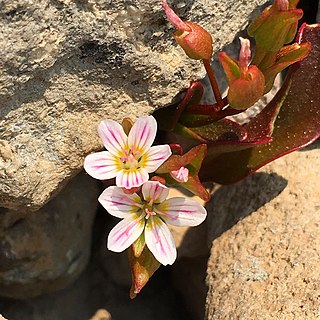
Claytonia nevadensis, known by the common names Sierra springbeauty and Sierra Nevada claytonia, is a species of wildflower in the family Montiaceae. The evolutionary relationship of Claytonia nevadensis to other claytonias is a subject of debate and ongoing genetic studies. Sierra springbeauties are diploid with a chromosome base number of x = 7

Claytonia palustris is a species of wildflower in the family Montiaceae known by the common names Jonesville springbeauty and marsh claytonia. Often mistaken for Claytonia sibirica, the species is diploid with a chromosome base number of x = 6.
Epilobium howellii is an uncommon species of flowering plant in the evening primrose family known by the common names Yuba Pass willowherb and subalpine fireweed. It is endemic to the High Sierra Nevada of California, where it is known from only about 65 occurrences.

Boechera breweri is a species of flowering plant in the family Brassicaceae known by the common name Brewer's rockcress.
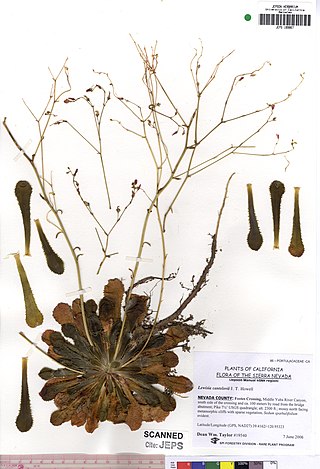
Lewisia cantelovii is an uncommon species of flowering plant in the family Montiaceae known by the common name Cantelow's lewisia. It is endemic to California, where it is known from the northeastern mountain ranges from the Klamath Mountains to the northern Sierra Nevada. It grows in rocky, moist mountain habitat. This is a perennial herb growing from a short, thick taproot and caudex unit. It produces a basal rosette of thick, fleshy, blunt-tipped spoon-shaped leaves with serrated edges. The inflorescence is a very slender erect stem up to 45 centimeters tall topped with a spreading panicle of flowers and glandular, toothed bracts. Each flower has 5 to 7 oval petals each one half to one centimeter long. The petals are white or very pale pink with sharp dark pink veins. At the center of the flower are five stamens tipped with dark pink anthers.
Lithophragma bolanderi is a species of flowering plant in the saxifrage family known by the common name Bolander's woodland star. It is endemic to California, where it is known from several mountain ranges, including the North Coast Ranges, the foothills of the Sierra Nevada, and the San Gabriel Mountains. It grows in many types of open habitat. It is a rhizomatous perennial herb growing erect or leaning with a tall naked flowering stem. The leaves are located on the lower part of the stem, each divided into rounded lobes. The stem bears up to 25 flowers, each in a cuplike calyx of red or green sepals. The five petals are white, under one centimeter long, and toothed or smooth along the edges.
Oenothera xylocarpa is a species of flowering plant in the evening primrose family known by the common name woodyfruit evening primrose. It is native to the Sierra Nevada of California, its range extending just into western Nevada. It grows in coniferous forest and meadow habitat, often in soils rich in pumice and other gravel. It is a perennial herb growing from a thick taproot and producing a flat, dense rosette of hairy, gray-green leaves. There is no stem. The showy flowers appear amidst the leaves. Each has four petals which may be nearly 4 centimeters long, bright yellow in color, fading pink to red with age. The fruit is a straight, curving, or twisting capsule which may be up to 9 centimeters long.
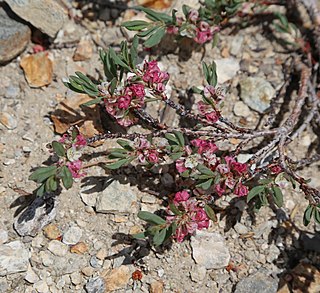
Polygonum shastense is a species of flowering plant in the knotweed family known by the common name Shasta knotweed. It is native to sections of southwestern Oregon, northwestern Nevada, and northern and central California, where it grows in rocky and gravelly mountainous habitat up to 3300 meters (11,000 feet) elevation. It is most common in the Sierra Nevada. The species name refers to its occurrence on Mount Shasta in Shasta County, California.

Sidalcea oregana is a species of flowering plant in the mallow family known by the common name Oregon checkerbloom.
Silene nuda is a species of flowering plant in the family Caryophyllaceae known by the common names western fringed catchfly and sticky catchfly.

Streptanthus tortuosus is a biennial or short lived perennial plant in the mustard family (Brassicaceae) known by the common names shieldplant, shieldleaf, and mountain jewelflower.

The flora of the U.S. Sierra Nevada alpine zone is characterized by small, low growing, cushion and mat forming plants that can survive the harsh conditions in the high-altitude alpine zone above the timber line. These flora often occur in alpine fell-fields. The Sierra Nevada alpine zone lacks a dominant plant species that characterizes it, so may or may not be called a vegetation type. But it is found above the subalpine forest, which is the highest in a succession of recognized vegetation types at increasing elevations.


















